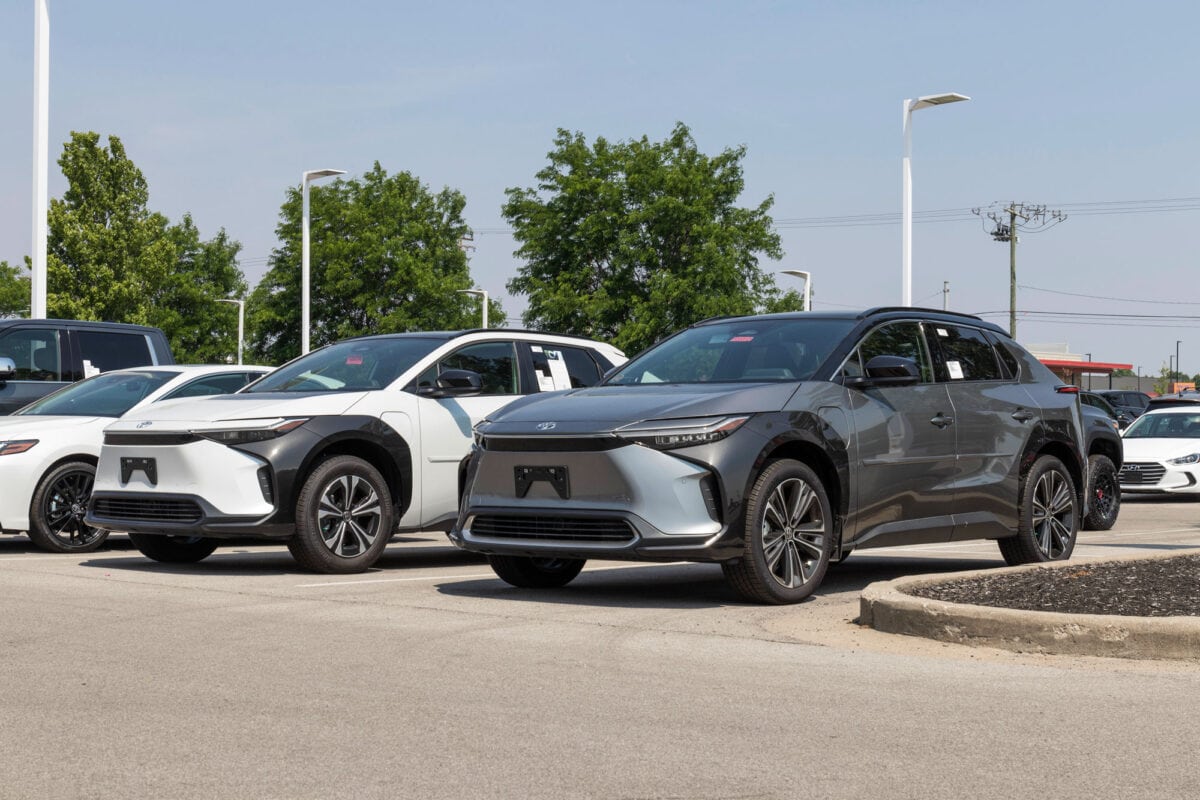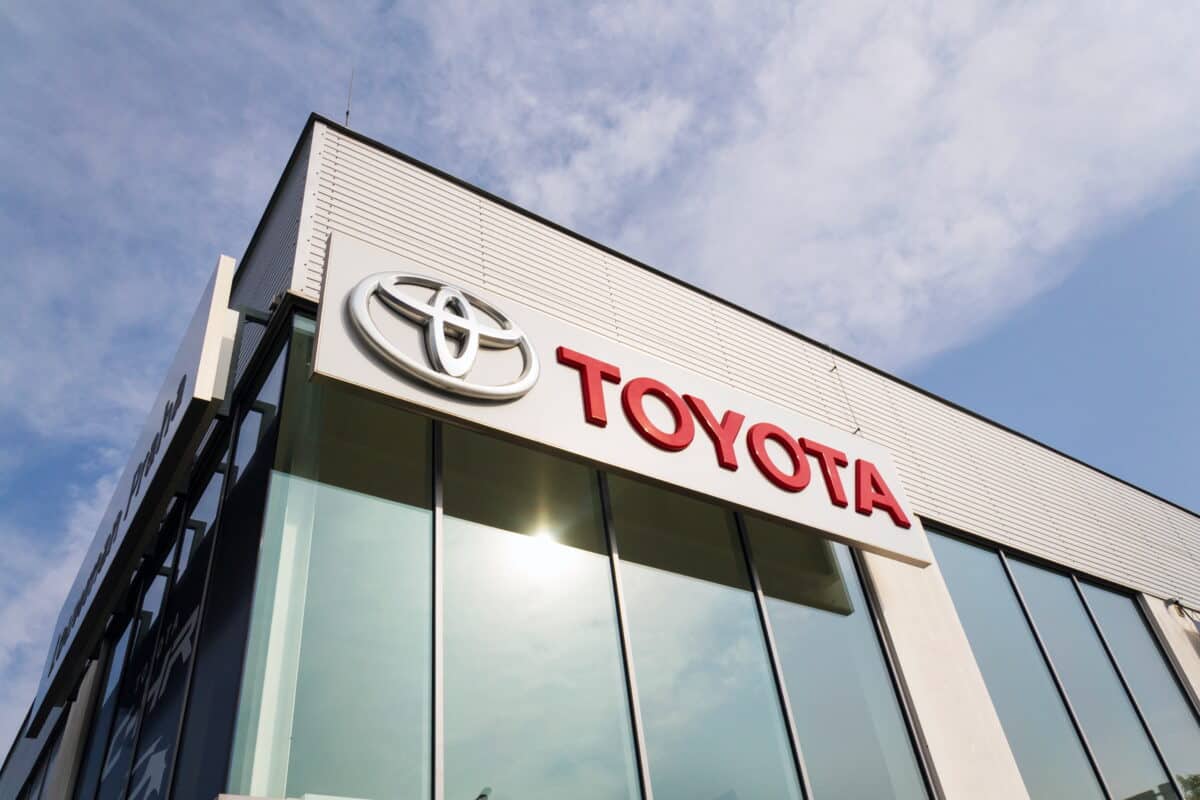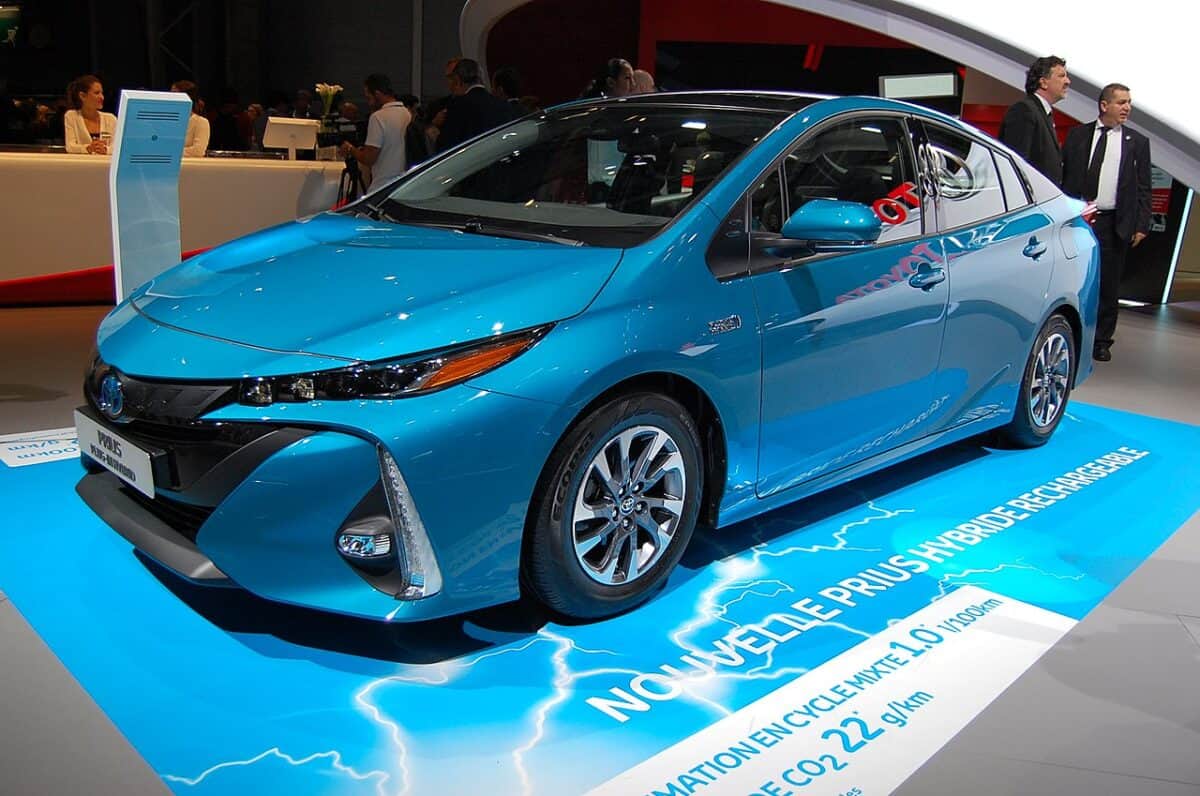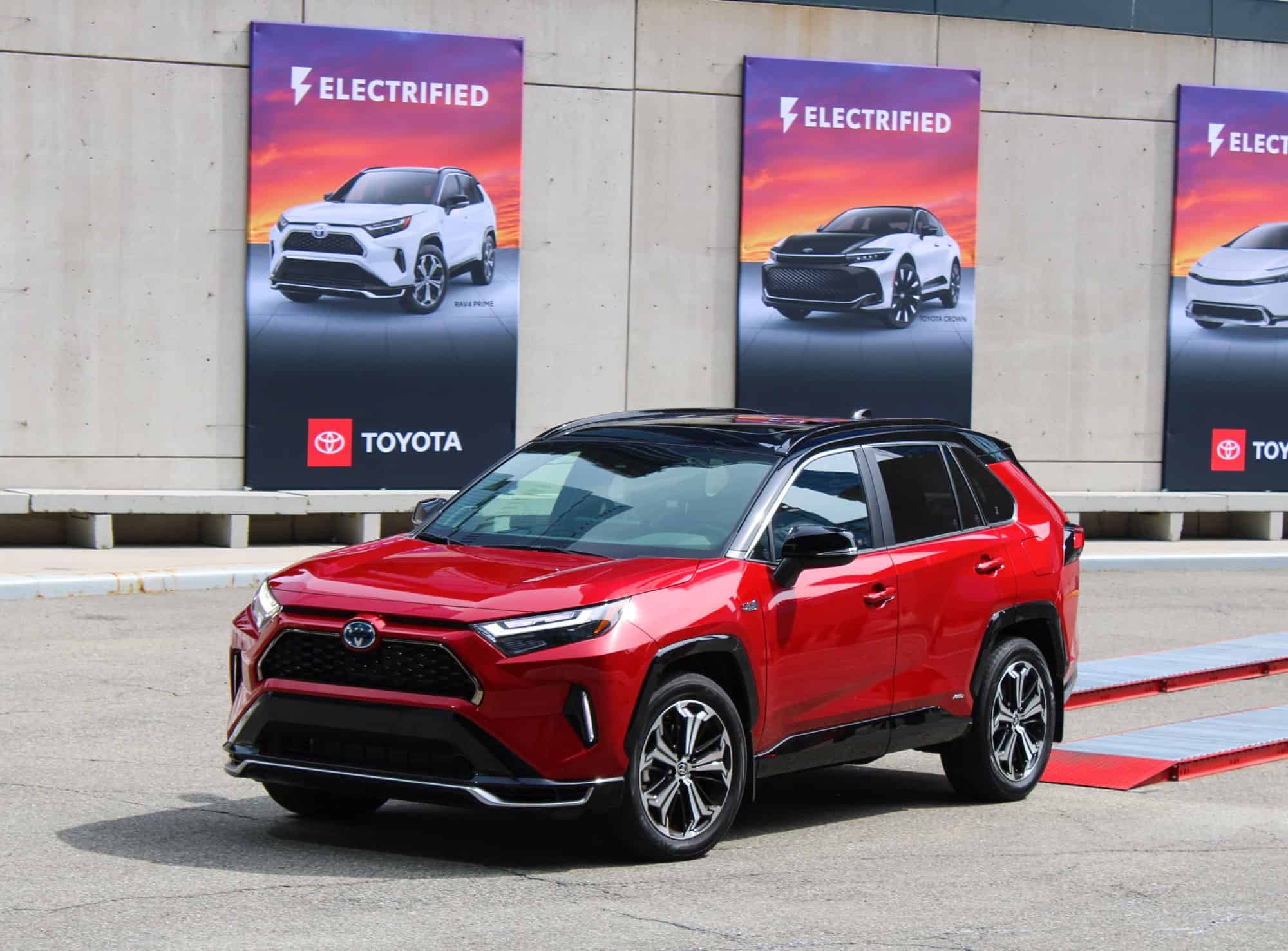Toyota is a latecomer to the world of electric vehicles, though it finally has a few EVs of its own on the road. The Japanese car manufacturer is a reluctant participant at best in the move to electrification. Forbes reports that Jack Hollis, executive vice president of sales at Toyota Motor North America, said in August that the market isn’t ready for electric vehicles. Hollis echoes a narrative that has been the company’s line for years.
Still, Toyota offers one new EV alongside several plug-in electric hybrids (PHEVs) and hydrogen vehicles, also known as fuel cell electric vehicles (FCEVs). It has other EVs in the works, though data is still scarce. Toyota also continues using money and R&D bandwidth for its FCEVs. Further, Car and Driver reports that Toyota promises another PHEV. Here’s the company’s current and potentially upcoming lineup of EVs, PHEVs, and FCEVs.
Toyota Electric Vehicles
2023 Toyota bZ4X Crossover SUV

©Jonathan Weiss/Shutterstock.com
The bZ4X crossover is the first all-electric Toyota vehicle available in the United States. Toyota’s name prefix for the vehicle, “bZ,” stands for “beyond zero,” and the 4X appears to be the first of a much larger future bZ family. The company has sold a tiny handful of these vehicles to the American public as of August 2022. The EV has appeared only at a few dealerships in several states, though availability should expand in the near future.
Seating five people in total, the Toyota bZ4X has an approximate range of 250 miles on a full charge, according to company estimates. Passengers are seated in a modern, comfortable, high-tech interior under a panoramic moonroof with a powered sunshade. The base XLE offers optional heated front seats, while the premium Limited trim boasts standard heated and ventilated front seats. The bZ4X provides 27.7 cubic feet of rear cargo volume with both seating rows in use. Folding down the rear seats boosts cargo volume to 56.9 cubic feet.
In terms of performance, Toyota’s EV all-wheel drive (AWD) crossover generates 201 horsepower and 196 pound-feet of torque. It accelerates from 0-60 mph in 5.8 seconds. The vehicle features regenerative braking, but testers report one-pedal driving is impossible.
The bZ4X theoretically takes 30 minutes to achieve an 80% charge on a DC fast charger. Charging on a Level 2 charger requires 9 hours. Trickling electricity into the battery through a Level 1 plug-in – household current – gives a 100% charge in 50 hours. Thus far, Toyota only offers a Level 2 home charger, with Level 3 only available at public chargers.

While Toyota has not been at they forefront of electric vehicle production, they do have a history of innovation and will catch up quickly.
©josefkubes/Shutterstock.com
bZ4X Crossover Problems
Toyota’s bZ4X has not enjoyed smooth sailing after its recent launch. The company issued a recall for 661 of the 2,700 bZ4X EVs currently in consumer hands. The recall notice on the NHTSA website reads, “Hub bolts on the wheels may loosen, causing a wheel to detach from the vehicle after low-mileage use.” It urges drivers not to use their bZ4X until a solution is available. Toyota describes the solution to the problem as “currently under development.”
Subaru is recalling its Solterra SUV EV as well, according to Lemberg Law. Subaru developed the Solterra in partnership with Toyota, possibly indicating a link between the two recalls.
Less catastrophically, Motortrend reports difficulties with fast charging at a DC charger with low or even moderate temperatures. Toyota itself warns DC charging may be seriously limited at around 32° F, and will likely become impossible at -4° F. Motortrend claims its testing showed considerable slowing of fast DC charging even at 64° F.
2024 Toyota Compact Cruiser
Toyota’s Compact Cruiser EV concept currently exists only as full-sized clay model and some CGI images, as reported by Motortrend. The chunky little SUV, which looks like a small, cartoonish version of a Land Rover, already won an award. Auto & Design magazine gave it the 2022 Car Design Award for concepts. The magazine cited the SUV’s “strong appeal” and called it a “rugged and modern utilitarian product that is also desirable, a hard feat to achieve.”
The Compact Cruiser, if Toyota ever makes it, will apparently have real off-road utility as a design goal. The clay model shows the Cruiser outfitted with all-terrain tires and, clearly, plenty of ground clearance. The EV is a four-door and features other off-road features, such as skid plates. Motortrend estimates it might be available in autumn 2023 and have a base price of around $45,000; however, these metrics appear to be pure guesswork.
15 EV Concept Mock-ups
The Compact Cruiser represents just one of the 15 EV concepts Toyota’s CEO revealed to the media in December 2021, Cars.com says. The digital image shows an assortment of possible EVs Toyota claims will start rolling off of production lines in just a few years.
The concepts include several new variants on the bZ line, including a “stretched” version likely holding three rows of seating. Other identifiable vehicles include a sports car, a pickup truck, a cargo van, a small runabout, and a minibus. Whether Toyota ever manufactures any of these EV models remains to be seen.
Toyota Plug-In Hybrids (PHEVs)
2022 RAV4 Prime

The Toyota 2022 RAV4 Prime is a crossover SUV, though engineers put more SUV DNA into its design than hatchback. The vehicle seats five occupants in an interior Edmunds describes as having “generous” room for passengers. The vehicle rides smoothly, but its handling is relatively poor. Its drivetrain engineering provides some notably sporty performance, boosting from a standstill to 60 mph in 5.6 seconds. This acceleration compares favorably to the 9.1 second 0-60 time for the equivalent ICE RAV4.
Ruggedly constructed, the RAV4 Prime hauls a decent amount of cargo, more than many crossovers. The cargo space behind the rear seats measures 33.5 cubic feet, rising to 69.8 cubic feet with the seats folded down. Toyota lists maximum payload as 1,295 pounds. Additionally, the RAV4 Prime tows up to 2,500 pounds. Though Toyota built the RAV4 Prime with only 8 inches of ground clearance, Green Car Reports says it has decent off-road moxie within that limitation.
Drivers can achieve 94 miles per gallon when driving the RAV4 Prime on combined gas and electric power. Its highway efficiency is 38 miles per gallon on gasoline only. The EPA rates its electric-only range at 42 miles, but users report 48 miles is attainable. The RAV4 recharges on either regular household current (Level 1) or on a Level 2 charger (240v). Level 1 charging brings the battery to 100% in approximately 12 hours. Recharging time on Level 2 is 4 hours, which an owner can slash to 2.5 hours with the optional enhanced charger system.
2022 Prius Prime

©Cxpr, CC BY-SA 4.0, via Wikimedia Commons – License
Toyota’s Prius Prime brings PHEV power to the familiar Prius platform. It’s part of the Prius phenomenon which has seen approximately 8 million of the cars sold worldwide. This PHEV model offers seating for 5 people and a hatchback configuration. The hatchback designs gives the Prius Prime 19.8 cubic feet of cargo space with the rear seats raised. Folding the seats increases potential room for cargo to 36.6 cubic feet.
In terms of range performance, the Prius Prime resembles a fairly typical hybrid. The EPA rates its combined gas and electric range at 54 miles per gallon. On the other hand, its electric-only range is a rather short 25 miles. Testers find the interior comfortable but the driving experience drab, especially compared to hard-charging modern EVs like the Tesla Model 3.
Toyota Hydrogen Fuel Cell Vehicles (FCEVs)
2022 Mirai FCEV
The 2022 Mirai FCEV is one of just two FCEVs available from manufacturers worldwide. Hydrogen cars have several advantages from both ICE and EV vehicles, and the Mirai is no exception. Drivers can fill the tank in a few minutes, precisely like pumping gas, and the fuel cell offers excellent range. FCEVs also share pluses with battery electric vehicles, such as zero emissions, with water as the main byproduct of operation. It also suffers from FCEV limitations, such as a lack of supporting infrastructure, with fuel stations currently available only in parts of California.
The Toyota Mirai seats five in total and features a typically comfortable, well-appointed Toyota interior to house them. Engineers built the 12.5-inch touchscreen into a larger audio, multimedia, and infotainment system with plenty of features, both standard and optional. The electronic system includes blind-spot monitoring and other driver assist programs.
Mirai performance resembles that of an ICE vehicle more than an EV. The rear-wheel drive powertrain develops 182 horsepower and 300 pound-feet of torque at maximum. 0-to-60 time is a lengthy 9.2 seconds. Drivers can switch between Normal, Eco, and Sport driving modes to adjust performance.
Environmental Protection Agency estimates peg the Toyota Mirai’s range at 402 miles on a tank of hydrogen fuel. Toyota provides free fuel refills to owners for 6 years or until purchases surpass $15,000. Future Mirai generations are said to offer even longer ranges, provided you can locate a hydrogen filling station.
Up Next…
Don’t stop reading now! We have plenty more great articles about EVs!
- Kia EV9 vs Rivian R1S: What We Know, and How They Compare So Far. We give you the pros and cons on these two vehicles.
- 2023 Hyundai Kona EV vs 2023 Kia Niro EV: How Do They Compare? Trying to decide between these two? We’ve broken them down so you don’t have to!
- Is Kia Quietly Becoming the Next Tesla With These EVS? Kia is definitely making some inroads in the industry… but how do they stack up against Tesla?
The image featured at the top of this post is ©The Global Guy/Shutterstock.com.






